

Link Cabinet. Link Cabinet is a single web page hosting solo shows where artists exhibit a single, site-specific artwork.
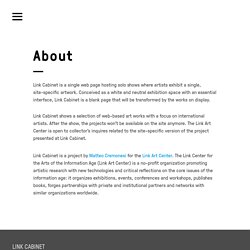
Conceived as a white and neutral exhibition space with an essential interface, Link Cabinet is a blank page that will be transformed by the works on display. Link Cabinet shows a selection of web-based art works with a focus on international artists. After the show, the projects won’t be available on the site anymore. The Link Art Center is open to collector’s inquires related to the site-specific version of the project presented at Link Cabinet. Link Cabinet is a project by Matteo Cremonesi for the Link Art Center. Terrapattern. Control of note velocities by facial expression.
Code as a Story - what are your stories? : creativecoding. Code as a Story - what are your stories? : creativecoding. Android tablet integrate Arduino-nano Instruction for Home Automation. Bestiario. CodexSeraphinianus. Gabinete Colectivo. Gabinete colectivo.
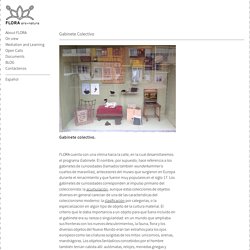
FLORA cuenta con una vitrina hacia la calle, en la cual desarrollaremos el programa Gabinete. Gabinetes De Curiosidades: Base De Los Museos - AlephZero@Comprendamos. M.

C. Miguel Fernando Pacheco Muñoz es maestro en Ciencias por la Universidad de Guadalajara y estudiante de la maestría en filosofía de la Ciencia en la Facultad de Filosofía y Letras. Cuartos de maravillas. Frontispicio de Musei Wormiani Historia mostrando el cuarto de maravillas de Worm.

En general en los cuartos de maravillas se exponían las curiosidades y hallazgos procedentes de nuevas exploraciones o instrumentos técnicamente avanzados, como por ejemplo en el caso de la colección de objetos del Zar Pedro el Grande.
MAXMSP-jitter. How to get more arduino analog inputs. I needed extra analog inputs for an arduino project and it seems a multiplexer was the way to go..
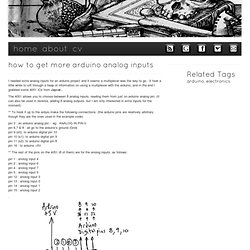
It took a little while to sift through a heap of information on using a multiplexer with the arduino, and in the end I grabbed some 4051 ICs from Jaycar.. The 4051 allows you to choose between 8 analog inputs, reading them from just on arduino analog pin. (It can also be used in reverse, adding 8 analog outputs, but I am only interested in extra inputs for the moment) ** To hook it up to the arduio make the following connections: (the arduino pins are relatively arbitrary, though they are the ones used in the example code) pin 3 : an arduino analog pin - eg: ANALOG IN PIN 0 pin 6,7 & 8 : all go to the arduino’s ground (Gnd) pin 9 (s0): to arduino digital pin 10 pin 10 (s1): to arduino digital pin 9 pin 11 (s2): to arduino digital pin 8 pin 16 : to arduino +5V ** The rest of the pins on the 4051 (8 of them) are for the anolog inputs, as follows: ** S0 = 1 , S1 = 2 and s2 = 4. Mel Bochner. Mel Bochner (born 1940) is an American conceptual artist.
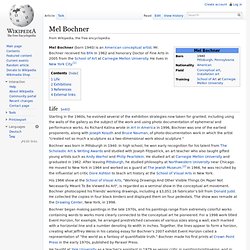
Mr. Bochner received his BFA in 1962 and honorary Doctor of Fine Arts in 2005 from the School of Art at Carnegie Mellon University. He lives in New York City.[1] Mel Bochner. Jim Blinn. James F.
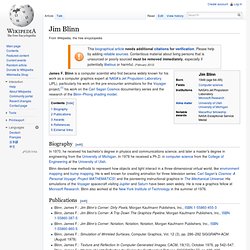
Blinn is a computer scientist who first became widely known for his work as a computer graphics expert at NASA's Jet Propulsion Laboratory (JPL), particularly his work on the pre-encounter animations for the Voyager project,[1] his work on the Carl Sagan Cosmos documentary series and the research of the Blinn–Phong shading model. Biography[edit] The quest for realism (James Blinn, 1980) Nullpointer. Qqq - Retinal-variables.png (imagen PNG, 576 × 490 píxeles) Las variables visuales. Se denominan variables visuales a aquellas características que diferencian un signo de otro. Las variables visuales. Jacques Bertin. Jacques Bertin (27 July 1918 – 3 May 2010[1]) was a French cartographer and theorist, known from his book Semiologie Graphique (Semiology of Graphics), published in 1967.
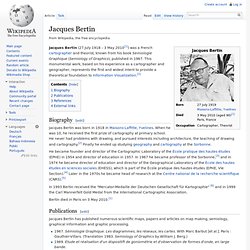
This monumental work, based on his experience as a cartographer and geographer, represents the first and widest intent to provide a theoretical foundation to Information Visualization.[2] Biography[edit] Jacques Bertin was born in 1918 in Maisons-Laffitte, Yvelines. When he was 10, he received the first prize of cartography at primary school. He never had problems with drawing, and pursued interests including architecture, the teaching of drawing and cartography.[2] Finally he ended up studying geography and cartography at the Sorbonne. He became founder and director of the Cartographic Laboratory of the École pratique des hautes études (EPHE) in 1954 and director of education in 1957. Kai Bernau +31 62 44 77 057. Philip Beesley: Hylozoic Ground. E-art - New Technologies and Contemporary Art - Philip Beesley. THE SECRET LIVES OF NUMBERS. THE SECRET LIVES OF NUMBERS.
The authors conducted an exhaustive empirical study, with the aid of custom software, public search engines and powerful statistical techniques, in order to determine the relative popularity of every integer between 0 and one million.
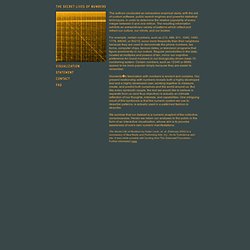
The resulting information exhibits an extraordinary variety of patterns which reflect and refract our culture, our minds, and our bodies. For example, certain numbers, such as 212, 486, 911, 1040, 1492, 1776, 68040, or 90210, occur more frequently than their neighbors because they are used to denominate the phone numbers, tax forms, computer chips, famous dates, or television programs that figure prominently in our culture. Software Art. Beckmap1.jpg (imagen JPEG, 1024 × 715 píxeles) Henry Charles Beck. The Barbarian Group - We make stuff the internet loves.
Paul Baran. Yunsil Heo & Hyunwoo Bang - Oasis, Tangible Visual Interface, 2008. Amy Balkin. Arp-2-sized.jpg (imagen JPEG, 228 × 307 píxeles) Jean Arp. Cory Arcangel. Early life[edit] Arcangel grew up in Buffalo, New York and attended the Nichols School, where he was a star[1] lacrosse goalie.
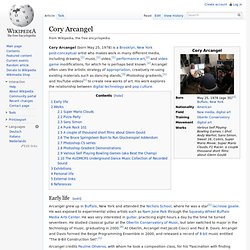
He was exposed to experimental video artists such as Nam June Paik through the Squeaky Wheel Buffalo Media Arts Center. He was very interested in guitar, practicing eight hours a day by the time he turned seventeen. He studied classical guitar at the Oberlin Conservatory of Music, but later switched to major in the technology of music, graduating in 2000.[4] At Oberlin, Arcangel met Jacob Ciocci and Paul B. Cory Arcangel's Official Portfolio Website and Portal. Aranda\Lasch News. Aranda Lasch » Aranda Lasch. Richard Anuszkiewicz. Richard Anuszkiewicz (pronounced Aah-Nuss-KAY-Vitch; born May 23, 1930, Erie, Pennsylvania) is an American painter, printmaker, and sculptor.[1] Life and work[edit] Richard Anuszkiewicz trained at the Cleveland Institute of Art in Cleveland, Ohio (1948–1953), and then with Josef Albers[2] at the Yale University School of Art and Architecture in New Haven, Connecticut (1953–1955) where he earned his Masters of Fine Arts.
Style[edit] Considered a major force in the Op Art movement, Anuszkiewicz is concerned with the optical changes that occur when different high-intensity colors are applied to the same geometric configurations. Most of his work comprises visual investigations of formal structural and color effects, many of them nested square forms similar to the work of his mentor Josef Albers. JUSSI ÄNGESLEVÄ's Portfolio. Ralph Ammer - Being not truthful. Cooperation with Stefan Sagmeister works against me "Being not truthful works against me" is part of a list in Stefan's diary titled: "Things I have learned in my life so far".
Like most aphorisms the sentence "Being not truthful works against me" requires habitual commitment. But one might also sense controversy in this statement and quesition not only the idea of "truth" but also the value of making truthfulness a rule. Untitled. Yacoov Agam, Double métamorphose III. Three Dimensions by Yaacov Agam.